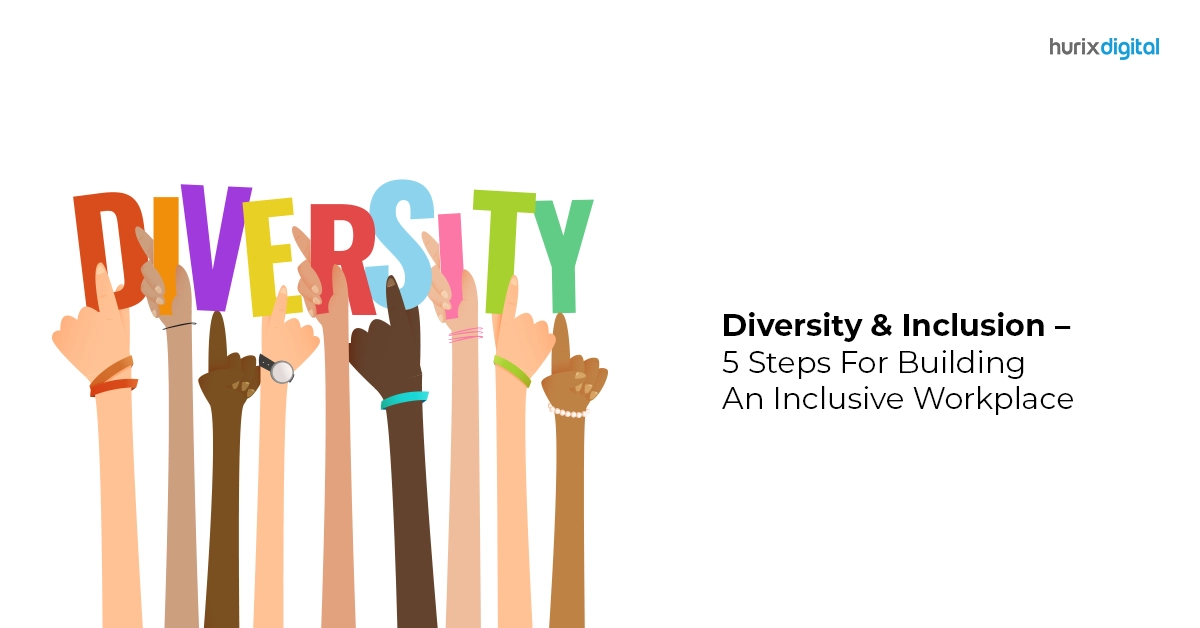
Diversity & Inclusion – 5 Steps For Building An Inclusive Workplace
Diversity and Inclusion (D&I) represent two of the most essential factors in creating and maintaining a workplace that’s completely safe, productive and welcoming for all.
Table of Contents:
– What is D&I And Why is it Important?
– Steps to Create a Diverse & Inclusive Culture
1. Establish a Sense of Belonging
2. Practice Inclusive & Empathetic Leadership
3. Integrate D&I Into Your Core Values
4. Acknowledge & Honor Different Religious & Cultural Practices
5. Model the Change
In the recent past, D&I has become much more than just the essential HR checklist items like policies, procedures and headcounts. The practice has grown into a cultural phenomenon in itself, and one that every organization needs to execute correctly for it to have a direct effect on the bottom line.
In this blog, we are going to discuss the importance of D&I at the workplace and how you can build a safe and inclusive workplace.
Also Read: How to Deliver POSH Training Effectively
What is D&I And Why is it Important?
While diversity in the workplace refers to building a robust culture that promotes a varied workforce that includes team members from different religions, ethnicities, cultures, genders and ableness, inclusion is largely the concept of utilizing that diversity in a way that every employee’s unique strengths are realized.
A diverse and inclusive workplace is essentially one that makes every employee or staff member, regardless of who they are or what their role is, feel equally involved and supported in all areas of the workplace.
There are several benefits of building a diverse and inclusive workplace –
- Diversity and inclusiveness foster a more creative and innovative workforce
- The practice allows businesses to create a competitive economy in today’s globalized world
- Employees who feel valued and heard at work are more likely to perform better
- A diverse and inclusive workforce drives economic growth and can capture a bigger share of the consumer market
5 Steps to Create a Diverse & Inclusive Culture:
Building a diverse and inclusive culture means taking targeted steps to create new policies and procedures or abolish some of the previous ones entirely.
Here are some ways to create a more diverse workforce –
1. Establish a Sense of Belonging
For every employee at the workplace to bring their best self forward, it is essential to create a sense of belonging in them. Having a powerful connection to the organization helps in bringing in much greater engagement and creativity in the workplace.
Some of the tips that can help achieve this objective include –
- Conducting diversity workshops and cultural training periodically to end unconscious bias and educating managers and employees about the importance of inclusiveness
- Creating a robust employee feedback system to give employees and managers a voice of their own
- Conducting a comprehensive evaluation of the workplace to assess how inclusive the work environment is
2. Practice Inclusive & Empathetic Leadership
Most organizations treat diversity and inclusion as a standalone initiative owned exclusively by HR teams. But to bring in true change, every leader in the company needs to own up the responsibility of following D&I practices through an inclusive and empathetic leadership style.
Leaders of organizations need to create a safe work environment where all employees feel heard and welcome and are able to speak up freely. They should make sure to embrace the input of every employee, especially the ones whose expertise and background differ from their own.
This helps leaders in fostering collaboration among diverse staff, giving actionable feedback, facilitating constructive arguments, and acting upon the advice of diverse employees.
Also Read: The Importance of Learner Paths in Employee Training
3. Integrate D&I Into Your Core Values
To be able to build a truly diverse and inclusive workforce, every organization needs to make it a habit to revisit its core values periodically and ensure that it follows a culture of inclusiveness.
Here are some of the ways through which you can achieve this –
- Take employee feedback regularly to check about their experience in the organization.
- Create a dedicated panel of members, ranging across different departments to ensure the transparency and fairness of the process.
- Ensure that employees belonging to different races, gender, culture, and ethnicities have a say in the decision-making process in the organization.
4. Acknowledge & Honor Different Religious & Cultural Practices
Honoring and acknowledging multiple cultural and religious practices at the workplace is a great start towards implementing D&I practices. One of the ways to do this is by focusing on holidays and celebrations.
When your employees feel satisfied and fully supported in their work environment, the company benefits from better productivity and higher employee retention.
Also Read: How to Deliver Gamified Content to Your Employees
5. Model the Change
Leaders must consciously and actively model their commitment to diversity and inclusion in order to inspire the staff and the rest of the organization to commit to bringing the change.
By making a visible commitment to inclusion and systematically launching an initiative that is focused on results, leaders can model the change they want to see, while inspiring employees to engage in the initiative at the same time.
Some of the tips to model the change and create a more diverse workforce include:
- Maintaining a holiday policy based on different cultures to make sure that your employees get leave for holidays that are not necessarily covered in the official company holiday calendar.
- Facilitate your hiring process to include candidates from a wide range of community outreach programs, hiring consultancies and job fairs. This will ensure that your organization hires a variety of diverse talents.
- Revisit your compensation policy to ensure that your company pays employees based on their skills and job title instead of their gender, race and sexual orientation.
Apart from these, some of the other D&I best practices that organizations should follow are –
a. Fair treatment and equal access to opportunities for every employee
b. A focus on innovation, creativity, teamwork and collaboration
c. Robust and collaborative conflict resolution processes
d. Organizational flexibility, agility and responsiveness
e. Representation of diversity and inclusivity at all levels of the organization
f. Dedicated diversity education and training
To Conclude
The concept of diversity and inclusion in the workplace continues to gain traction in the corporate world as its benefits have become increasingly clear.
If businesses wish to grow and thrive in today’s competitive work environment, it’s imperative to embrace diversity and inclusivity practices as it leads to better teams, more efficient decision making and greater innovation.
To be able to do this, business leaders must come together and address discrimination that continues to hinder workplaces. The need is to unleash every talent and, in the process, create more equity, profit and a safe & healthy work environment.
Need to know more about our products and services? Drop us a note on marketing@hurix.com

A highly enthusiastic and motivated sales professional with over twenty five years of experience in solution selling of training-related applications and services. Maintains an assertive and dynamic style that generates results. Ability to establish long-term relationships with clients built on trust, quality of service and strategic vision. Specializes in financial services, higher ed, publishing and government in the areas of learning and development.



